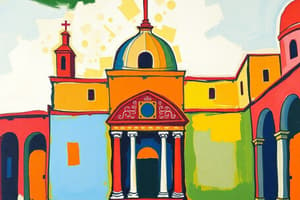Podcast
Questions and Answers
What is the primary function of the Catacomb of Priscilla?
What is the primary function of the Catacomb of Priscilla?
- To display artwork
- To hold public gatherings
- To house tombs for early Christians (correct)
- To serve as a church
The Catacomb of Priscilla is located in Alexandria, Egypt.
The Catacomb of Priscilla is located in Alexandria, Egypt.
False (B)
Who was the wealthy Christian patron who gifted the land under the Catacombs?
Who was the wealthy Christian patron who gifted the land under the Catacombs?
Priscilla
What significant event happened to Sabina related to the Santa Sabina church?
What significant event happened to Sabina related to the Santa Sabina church?
What does the design of Santa Sabina feature?
What does the design of Santa Sabina feature?
Who commissioned the San Vitale church in Ravenna?
Who commissioned the San Vitale church in Ravenna?
San Vitale has no connection to Italian influences in its design.
San Vitale has no connection to Italian influences in its design.
What type of architectural elements does the Hagia Sophia incorporate?
What type of architectural elements does the Hagia Sophia incorporate?
What is one feature of the Hagia Sophia's interior?
What is one feature of the Hagia Sophia's interior?
What role did Theodora play in Justinian's reign?
What role did Theodora play in Justinian's reign?
The mosaics of Justinian and Theodora are designed to create a sensory overload.
The mosaics of Justinian and Theodora are designed to create a sensory overload.
Study Notes
Catacomb of Priscilla
- Located in Rome, Italy, dates back to c. 200-400 CE, constructed with excavated tufa and fresco.
- Contains approximately 40,000 tombs primarily for early Christian martyrs and saints.
- Tunnels extend about 5 miles, meticulously hand-carved from tufa stone, featuring "liccoli" or narrow passages.
- Entryways showcase various painting orders; the site was gifted by a wealthy Christian, Priscilla, who is interred there.
- Early Christians used underground catacombs for safety amid Roman persecution; rich iconography and symbolism reflect their faith.
Santa Sabina
- Constructed in Rome, Italy from 422-432 CE, using brick, stone, and wooden roof.
- Named after Saint Sabina, a martyr who was executed for her Christian faith; the church represents rising Christian influence.
- Features an elongated, rectangular plan and sophisticated decoration, highlighting public expression of Christian values.
- Established on a hill following Constantine’s legalization of Christianity, with distinctive panel doors influencing church architecture.
San Vitale
- Situated in Ravenna, Italy, built between 526-547 CE from brick and marble veneer.
- Employs a central plan structure with three levels, incorporating clerestory and early flying buttresses.
- Retains Italian architectural influence alongside innovative designs of the Byzantine era.
- Ravenna served as a pivotal capital during the decline of the Western Roman Empire, later taken by Justinian for restoration efforts.
Justinian and Theodora Mosaics
- Created in San Vitale, Ravenna during c. 526-547 CE, utilizing intricate mosaic techniques.
- Aims to evoke spiritual fervor and demonstrate imperial power through vivid patterns and colors.
- Features Emperor Justinian at the center, displayed in dark robes, alongside a mosaic of his wife, Theodora.
- Theodora's rise from humble beginnings as a performer to a powerful figure in the Byzantine court underscores her significance in history.
Hagia Sophia
- Found in Constantinople (now Istanbul), built by Anthemius of Tralles and Isidorus of Miletus from 532-537 CE, using brick, ceramics, and mosaic details.
- Merges early Christian, Byzantine, and Islamic influences in its architectural design, reflecting a confluence of cultures.
- Characterized by multiple half domes, clerestories, and vibrant interior featuring Christian imagery and Islamic calligraphy.
- Originally constructed as a church by Justinian, it symbolizes the religious and cultural fusion within the Byzantine Empire.
Studying That Suits You
Use AI to generate personalized quizzes and flashcards to suit your learning preferences.
Description
Test your knowledge of Early Christian Art with this flashcard quiz focusing on the Catacomb of Priscilla. Discover its significance in late antique Europe and its role in the worship of martyrs and saints. Perfect for AP Art History students preparing for exams.




